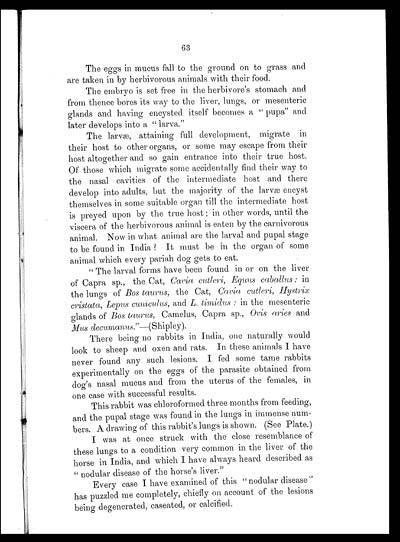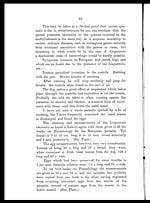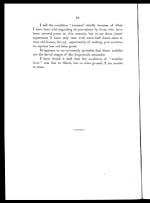Medicine - Veterinary > Civil Veterinary Departments > Indian Civil Veterinary Department memoirs > No. 2 - Collected notes
(246) Page 63
Download files
Individual page:
Thumbnail gallery: Grid view | List view

63
The eggs in mucus fall to the ground on to grass and
are taken in by herbivorous animals with their food.
The embryo is set free in the herbivore's stomach and
from thence bores its way to the liver, lungs, or mesenteric
glands and having encysted itself becomes a "pupa" and
later develops into a "larva."
The larvæ, attaining full development, migrate in
their host to other organs, or some may escape from their
host altogether and so gain entrance into their true host.
Of those which migrate some accidentally find their way to
the nasal cavities of the intermediate host and there
develop into adults, but the majority of the larvæ encyst
themselves in some suitable organ till the intermediate host
is preyed upon by the true host; in other words, until the
viscera of the herbivorous animal is eaten by the carnivorous
animal. Now in what animal are the larval and pupal stage
to be found in India? It must be in the organ of some
animal which every pariah dog gets to eat.
"The larval forms have been found in or on the liver
of Capra sp., the Cat, Cavia cutleri, Equus caballus: in
the lungs of Bos taurus, the Cat, Cavia cutleri, Hystrix
cristata, Lepus cuniculus, and L. timidus: in the mesenteric
glands of Bos taurus, Camelus, Capra sp., Ovis aries and
Mus decumanus."—(Shipley).
There being no rabbits in India, one naturally would
look to sheep and oxen and rats. In these animals I have
never found any such lesions. I fed some tame rabbits
experimentally on the eggs of the parasite obtained from
dog's nasal mucus and from the uterus of the females, in
one case with successful results.
This rabbit was chloroformed three months from feeding,
and the pupal stage was found in the lungs in immense num-
bers. A drawing of this rabbit's lungs is shown. (See Plate.)
I was at once struck with the close resemblance of
these lungs to a condition very common in the liver of the
horse in India, and which I have always heard described as
"nodular disease of the horse's liver."
Every case I have examined of this "nodular disease"
has puzzled me completely, chiefly on account of the lesions
being degenerated, caseated, or calcified.
Set display mode to: Large image | Zoom image | Transcription
Images and transcriptions on this page, including medium image downloads, may be used under the Creative Commons Attribution 4.0 International Licence unless otherwise stated. ![]()
| India Papers > Medicine - Veterinary > Civil Veterinary Departments > Indian Civil Veterinary Department memoirs > Collected notes > (246) Page 63 |
|---|
| Permanent URL | https://digital.nls.uk/75512724 |
|---|
| Shelfmark | IP/RA.10. |
|---|---|
| Additional NLS resources: | |




